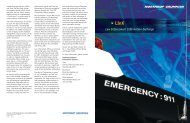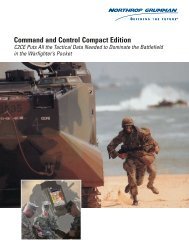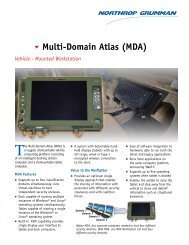Pythagoras: A New Agent-based Simulation System - Northrop ...
Pythagoras: A New Agent-based Simulation System - Northrop ...
Pythagoras: A New Agent-based Simulation System - Northrop ...
Create successful ePaper yourself
Turn your PDF publications into a flip-book with our unique Google optimized e-Paper software.
<strong>Pythagoras</strong>: A <strong>New</strong> <strong>Agent</strong>-<strong>based</strong> <strong>Simulation</strong> <strong>System</strong><br />
The midshipman first created a base case from the historical record, setting a scale for<br />
the battle (in terms of miles per pixel), speeds of the combatants (pixels per time step),<br />
and various sensor and weapon capabilities. He estimated the capabilities using the<br />
historical record for ships sighted, weapons launched, and ship damage in the base case.<br />
He then altered the decision made by the Japanese, sending the bombers alone in one<br />
case and adding some of the available fighter escorts in another.<br />
He found that the results on the Japanese carrier fleet were the same—all four carriers<br />
were sunk regardless of the Japanese admiral’s decision. However, the decision to send<br />
the attack aircraft armed with bombs would have resulted in the loss of one to two U.S.<br />
carriers, had they gone in alone; or two to three U.S. carriers, had they gone with escorts<br />
and detected the U.S. carrier that was operating alone. Since the Japanese at the time<br />
still had carriers operating in the Aleutians and the Coral Sea, and the United States had a<br />
total of just three carriers in the Pacific, the strategic result could have been dramatically<br />
different, delaying the U.S. counteroffensive in the Pacific.<br />
The midshipman was able to build the base case in a few days, calibrate it, and complete<br />
the model runs in less than one week.<br />
Clearing Shallow-Water Obstacles. The Marine Corps was searching for a near-term<br />
solution to the problem of shallow-water obstacles used to disrupt or defeat a Marine<br />
Corps surface assault. One proposed option was to use bombs—specifically, the 2000-lb<br />
Joint Direct Attack Munition (JDAM)—to clear shallow-water obstacles and mines. A<br />
JDAM could use impulse and overpressure to detonate mines close to the explosion.<br />
More distant mines would be pushed aside by the blast plume, which propagates well in<br />
water. That capability was tested at Eglin Air Force Base, Florida, in a shallow pond,<br />
carefully measuring the effects of various sizes of bombs in various depths of water. The<br />
necessary number of bombs remained to be determined, as well as spacing and delivery<br />
accuracy. The question posed to Project Albert was, “Could <strong>Pythagoras</strong> help at all?”<br />
In answering that question, it was ascertained that, while physics can measure the<br />
behavior of objects in the physical world, <strong>Pythagoras</strong> can measure behaviors as well. To<br />
use <strong>Pythagoras</strong>, we had to reproduce in <strong>Pythagoras</strong>’ terms the physical behavior of the<br />
various components of the system. Mines and obstacle agents were created, as were<br />
amphibious assault vehicle (AAV) agents.<br />
The AAV agents’ behavior was modeled such that they maintained specified spacing<br />
between one other as they moved through a series of way points. That behavior allowed<br />
the AAVs to form a ragged column and move ashore. Each AAV stopped whenever it<br />
encountered an obstacle, because the obstacle would suppress the AAV by firing a<br />
nonlethal weapon at it. However, the mine would fire a lethal weapon at the AAV at the<br />
range of half its width, representing the effect that resulted when the AAV hit the mine.<br />
With just one shot per mine, each mine killed at most one AAV.<br />
To enable the JDAMs’ effects to work properly in <strong>Pythagoras</strong>, two components were<br />
required: destruction and movement. To model the destruction and movement effects, a<br />
bomber agent (B-2) was created to drop the JDAMs on hit-point agents. The placement<br />
of the hit points represented the various options for weapon delivery and overall<br />
accuracy, combining target location error and weapon delivery error into a single offset<br />
from the weapon aim point. The mines and obstacles initially perceived the aim points to<br />
be neutral, because appropriate sidedness (color) values were used. However, when the<br />
hit points were actually attacked by an indirect-fire weapon—the JDAM—all mines that<br />
Technology Review Journal • Spring/Summer 2003 55






